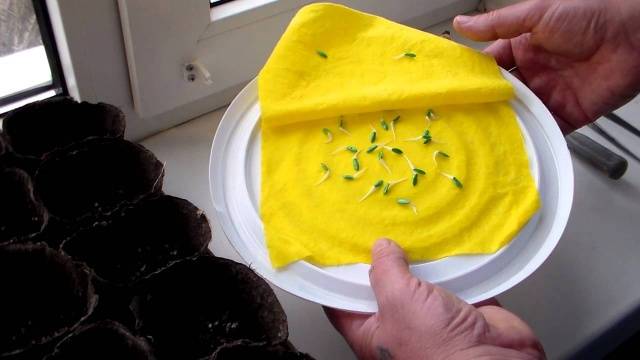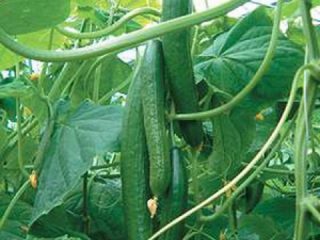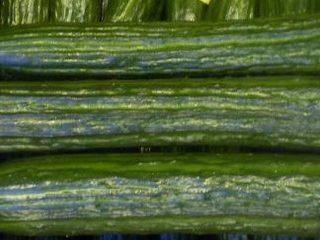Content
- 1 At what temperature should seedlings be grown?
- 2 When seedlings are planted in the garden
- 3 At what temperature should seeds be stored?
- 4 Preparation procedures before sowing
- 5 Features of the composition of soil for seedlings
- 6 Where to plant seedlings
- 7 The process of planting prepared seeds
- 8 Features of feeding and watering
Every gardener dreams of getting a rich harvest. To grow For a crop such as cucumber, it is worth sowing seedlings first. Despite its apparent simplicity, when growing seeds, a number of conditions must be observed. These include the optimal level of humidity, soil composition, and room temperature. Optimal temperature conditions are also important for preserving seed germination and sprout development in open ground.
At what temperature should seedlings be grown?
Pots with sown cucumber seeds are left at a temperature of about 25-28 degrees. This mode is recommended for growing seeds until seedlings appear.
Then the containers with cucumber seedlings are placed in a cooler room. To avoid stretching of young shoots, a temperature of 18-20 degrees is preferable. It is also important to provide the seedlings with sufficient lighting; if there is a lack of sunlight, special lamps are used. One more thing - as it grows, it’s worth adding soil.
There are other recommendations that will help you grow strong seedlings at home:
- Plant seeds should be planted in separate pots; the crop does not tolerate root deformation and replanting;
- use warm water to water the seedlings;
- The containers must be placed at such a distance from each other that their leaves do not shade neighboring pots.
Before planting, the sprouts are hardened off. They are placed in a cooler room, where the temperature is about 17 degrees.
When seedlings are planted in the garden
Plants can be planted after they have three true leaves. In this case, the air temperature outside should be at least 18-20 degrees, and the soil should warm up to 16-18 degrees.
A week or two before transplanting, the seedlings are hardened off. It can either be taken outside or placed on the balcony. During the day, containers with plants are watered abundantly.
Some preparation needs to be done in the garden. This includes:
- fertilizing the soil, add 1-2 buckets of compost per square meter of land;
- preparing the holes in which the seedlings will be planted;
- abundant watering, plan 1 liter of water for each hole.
If the seedlings were kept at home in peat pots, then they are buried in the holes to the edges of the container. When using plastic cups, their walls are cut, the sprout is removed along with a lump of earth and placed in the hole. After this, the plants are watered (for each cucumber - 3 liters of water), and light soil is sprinkled on top.
If the sprout is strong and properly developed, it is planted in a vertical position.The stretched seedlings are placed in the ground in an inclined state, and soil is added to the bottom of the stem. To prevent the occurrence of root rot, river sand is applied to the root collars.
At what temperature should seeds be stored?
You can grow a crop of cucumbers either from store-bought seeds or from seeds you prepare yourself. The optimal temperature for their storage is 15 degrees or less, air humidity is within 50-60%. Under such conditions, seed germination is maintained for 10 years. However, to get a bountiful harvest, it is recommended to use 3-year-old seeds for planting.
We must not forget that only seeds of varietal cucumbers can be left for planting. In this case, it is better to wait two to three years for the bushes to bear fruit well. Seeds from last season do not produce a bountiful harvest.
When using purchased seeds, it is important to read the information on the package. If they are treated with compounds to protect against pests and improve growth, they do not need to be soaked before planting. Otherwise, you can simply wash off the treatment layers from the seeds.
Preparation procedures before sowing
In order for the seeds to sprout faster and subsequently grow well, they need to be prepared for planting. Several procedures are involved in the preparation of untreated seeds.
- Rejection. To immediately discard seeds that will not sprout, they are soaked in a 5 percent saline solution. Mix the salt and seeds thoroughly and wait a few seconds. Those that settle to the bottom are of high quality and suitable for planting. Empty seeds will rise and can be discarded immediately.
- Disinfection. The seeds are soaked in a solution of potassium permanganate (1 g per half glass of water) and left for 30 minutes. After treatment, rinse under running water.
- Germination. Before sowing the seeds, they are wrapped in a damp cloth and left for a couple of days. It is recommended to cover the container with the cloth to keep it moist. Seeds are planted that have roots that have appeared and have reached three millimeters.
- Hardening. This procedure is required when the seeds are planned to be planted directly into the ground. To harden the seeds, they are placed wet in the refrigerator and kept for 36 hours.
Prepared and germinated seeds are lowered into the soil to a depth of no more than one and a half to two centimeters. To make them sprout faster, immediately after planting they are covered with film. When green sprouts appear, the covering is removed.
Features of the composition of soil for seedlings
In order for cucumber seedlings to develop properly, along with optimal temperature conditions, they require fertile soil. One of the best options contains:
- turf land;
- peat;
- sand;
- drainage.
Drainage is a layer of expanded clay or similar material that is placed on the bottom in a small layer to drain excess moisture. It is also not recommended to use peat alone for planting seeds, as it dries out quickly.
Where to plant seedlings
As for containers, a pot for cucumber seedlings can be bought ready-made or made from improvised materials. Several options will be considered below.
- Peat pot. One of the most convenient solutions for seedlings of cucumbers and other crops that do not respond well to transplantation.Plants are planted in open ground directly with the pot, so the root system is not damaged during transplantation and the sprout takes root well. When purchasing them, it is worth considering two points. The soil in peat pots dries out very much, so gardeners often place them in plastic containers. Also, in the three weeks that the cucumber seedlings are at home, they greatly lose their appearance. Here, an additional plastic container will also be very useful.
- EM trays for seedlings. These containers are a tray with special plates. They are inserted into each other, resulting in cells where the seeds are planted for seedlings. When planting plants, the entire plate is removed, the sprout along with a lump of earth is removed from it with a shovel and placed in the ground. Thanks to this, the roots are less damaged, and the cucumber seedlings take root better.
- Cassette. A similar option, only here separate cells with drainage holes have already been formed. Due to the fact that all containers are the same size, the seedlings grow evenly. Seed cassettes placed on a tray are easy to care for. However, during operation, plastic cells often become deformed.
- Peat tablets. Also a convenient option, they are placed entirely in the soil. For cucumber seeds, it is preferable to take tablets with a diameter of 42-44 mm.
It is worth considering that on average it takes three weeks for seedlings to grow. After this period, it needs to be planted in the garden. Overgrown seedlings take root much worse, so the seeds need to be sown 20-25 days before the planned transplant.
The process of planting prepared seeds
When the seeds are ready for planting, separate containers are taken for them. You can also see large boxes for seedlings on sale.But when transplanting from a common container, the roots of the seedling are injured. Considering which seedlings do not take root well in the garden and which ones adapt to new conditions, the sprout needs to be planted together with the entire lump of earth. Then the risk of damage to the root system is minimized.
It is preferable to plant two seeds in each pot. When the shoots appear and the cotyledon leaves open, you need to evaluate the condition of the sprouts. The strongest and healthiest one is left, the second one is cut off at soil level. If there are two sprouts in a pot, they will compete for light and water and will become weak as a result.
During growth, seedlings go through the following stages.
- Planting germinated seeds. While the shoots are not visible, the pots are kept at a temperature of 25-28 degrees and covered with film to speed up growth.
- Temperature drop to 18-20 degrees. When seedlings appear, it is recommended to lower the temperature and increase lighting. This measure will prevent the subcotyledon from stretching, and the seedlings will turn out strong.
- Addition of soil. It is recommended to do this once or twice during the period of growing cucumber seedlings.
- Application of fertilizing. It is worth using fertilizer specifically for cucumber seedlings.
- Hardening before planting in the ground. This procedure should be carried out a week before the planned move of the seedlings. The room temperature is reduced to 16-18 degrees or the cucumber seedlings are taken out to the balcony.
Features of feeding and watering
To water cucumber seedlings, use only warm water. It is recommended to moisten the soil in the morning.
To saturate the soil, complex fertilizers are used.While the cucumbers are kept indoors, it is worth taking special mixtures for seedlings.
For bushes planted in garden beds, it is better to prefer foliar feeding. The nutritional composition is sprayed onto the leaves of the plant. In this case, the nutrients are more likely to be used for their intended purpose.
As a top dressing, take a solution of ammonium nitrate at the rate of 5 g of the substance per liter of water. Also use a solution urea, Kemira-Lux or specialized fertilizer.
Apply the composition in the evening. If you spray the solution on the leaves during the day in clear weather, the water will quickly evaporate. The concentration of substances will increase greatly, and this will do more harm than good. You also need to make sure that the plants have time to dry before nightfall. They are very vulnerable to high air humidity. Moreover, this is more pronounced in cucumbers than in other crops.
Keeping seedlings at home and their subsequent transplantation have their own characteristics. For seed germination, the optimal room temperature is about 25 degrees. It should be lowered early after emergence to avoid sprouts being stretched out. In addition to optimal temperature, lighting and moderate moisture are important for cucumber seedlings. You need to replant sprouts that have 2-3 full leaves. Strong and timely planted seedlings will quickly take root in a new place and subsequently produce a bountiful harvest.






















